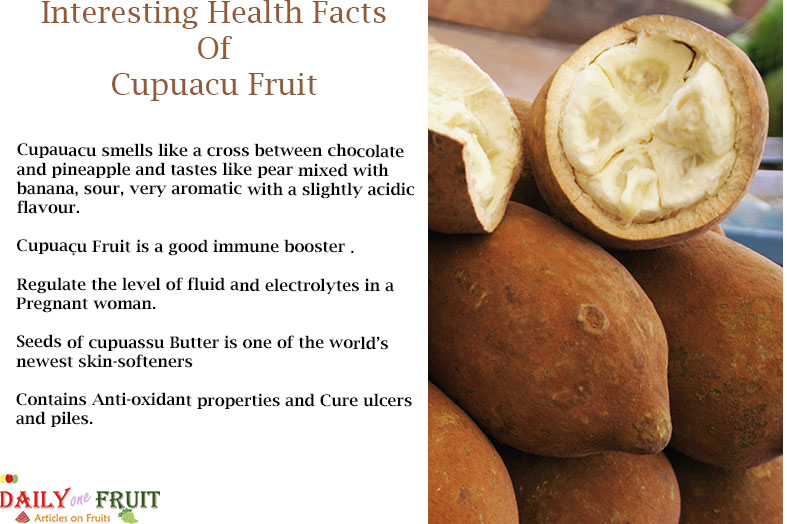
Interesting Facts Of Cupuacu Fruit
Cupuacu Fruit Botanically named as “ Theobroma grandiflorum ”.
Cupuacu Fruit is called as “ Food of the Gods ”
Origin Of Cupuacu Fruit
Family: Malvaceae (formerly Stericuliaceae)
Native and common throughout the Amazon basin, it is naturally cultivated in the jungles of Colombia, Bolivia and Peru and in the north of Brazil, with the largest production in Pará, Amazonas and Amapá
Other Names Of Cupuacu Fruit
Brazilians call this fruit cupuaçu ( pronounced coo-poo-asoo ), Amazonian superfood, Brazilian Cocoa, Copoasu, Large-Flowered Cocoa, Cupuasu, Cupuacu, cupuazú, cupu assu, Copoasu, Cupuacu, Amazon as “ the pharmacy in a fruit ”.
Appearance Of Cupuacu Fruit
Cupuacu ( pronounced koo-poo-ah-soo ) is a delicious melon-sized fruit.
Cupuacu fruit is ovular oblong, fluffy and rind is brown in color, 20-25 cm long, and 10-13 cm in diameter, which is about 8 inches long and weighs between 1 to 2 kg.
The Cupuacu pulp surrounded by a cream colored, fibro-succulent, with seeds.
The Cupuacu fruit is very fragrant and smells like banana.
Tastes Of Cupuacu Fruit
Cupuacu smells like a cross between chocolate and pineapple and tastes like pear mixed with banana, sour, very aromatic with a slightly acidic flavor .
Varieties Of Cupuacu Fruit
In Pará, three cultivars of cupuaçu are known: Redondo, with its rounded end, which is the most common; Mamorano, which has a pointed end and produces the biggest fruits; and Mamau, possibly a parthenocarpic mutant.
Nutritional Content Of Cupuacu Fruit
Cupuacu fruit There are plant food polyphenols (theograndins) in it. It is also rich in vitamins B1, B2, B3 (Niacin), fat and amino acids, and at least nine antioxidants (including Vitamins A and C).
100gram of Capuacu pulp contains
- Carbohydrates: 8 g
- Protein : 2 g
- Calcium : 40mg
- Phosphorous : 310mg
- Vitamin C : 4-23mg
- Total Fat (lipid) :13.6 g (38.86%)
- Vitamin E (alpha-tocopherol): 0.08 mg (0.53%)
Interesting Facts Of Cupuacu Fruit
- Boosts Immune System: Cupuaçu Fruit contain good immune booster contents such as vitamins A, C and Complex B, in addition to phosphorus, calcium, potassium, and fibres. These nutrients are considered as main ingredient to strengthen the body and the immune system. Finally Cupuaçu fruit is considered as best therapeutic property that helps to keep the body’s defense mechanisms healthy.
- Improves Energy Levels: The Cupuaçu fruit gives a great benefit, because it has micro-nutrients that increase energy levels consequently. The Cupuaçu fruit considerably act as energy booster and also comparably considered as less theobromine, theophylline and caffeine than cocoa beans.
- Rejuvenates Skin: Capuacu fruit is a rich source of antioxidants such as polyphenols, flavonoids, saponins, and vitamin C, which help delay the skin aging process, and anti-bacterial properties helps to deal with various skin issues and skin infection.
- Enhances Eye Sight: Capuacu Fruit contains no caffeine and thus, it is capable of keeping the body cells hydrated and moisturized.Vitamin A and rhodopsin are also abundant in Capuacu fruit which gives a purple pigment and also helps us to reduces macular degeneration and cataracts.
- Strengthen Bones: The Capuacu fruit is an abundant source of vitamins A, C, B1, B2, and B3. Capuacu fruit is great for the bones, ligaments, and tendons as a result of its high amino acids content, as well as calcium and selenium.
- Good for Respiratory System: Phytonutrient polyphenols are good for treatment of respiratory illnesses .These Phytonutrient present in Capuacu, but not in many other fruits which is extremely helpful in the treatment of respiratory illnesses like asthma, bronchitis, and sore throat.
- Treats Weight Loss: Capuacu aids in healthy weight loss, addition of vitamins and minerals, so-called fruit contains soluble fiber pectin, which aids in weight loss, because it produces a sociogenic effect, found in many anti-obesity drugs.
- Helps Pregnancy Women. Capuacu fruit hold high amount of potassium that help to regulate the level of fluid and electrolytes in a pregnant woman’s body . Capuacu fruit help in relieving constipation complication during the pregnancy period.
- Combats Kidney problems: Capuacu fruit however said to have rich Potassium a mineral that maintain blood pressure and kidney functions. Another vital vitamin for kidney functioning is niacin ,helps the body to produce energy and in enzyme functioning.
- Promotes Heart Health: The Fruit also strengthens cardiovascular system and protects the artery walls from damage which can cause heart diseases. Fatty acids present in the fruit reduce the bad cholesterol and lower the blood pressure and helps in eliminating the free radicals.
- Improves Digestion: Capuacu fruit had laxative properties due to being rich in fiber and Vitamin C, which helps manage constipation and indigestion naturally. It contains tannin and phenolic compounds that are high in anti-oxidant properties and helpful against ulcers and piles.